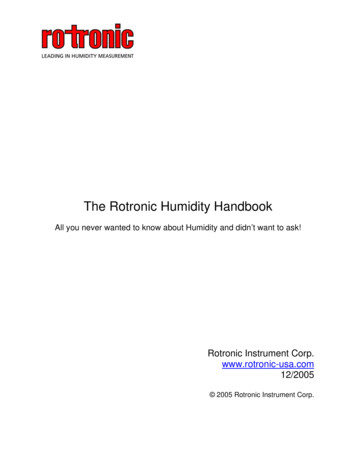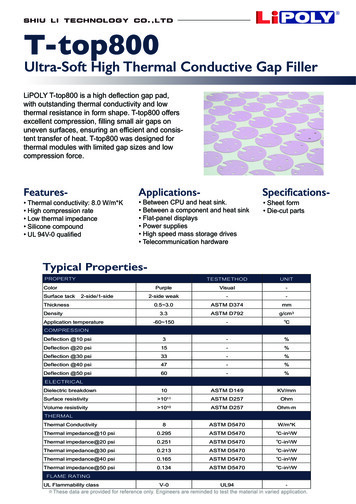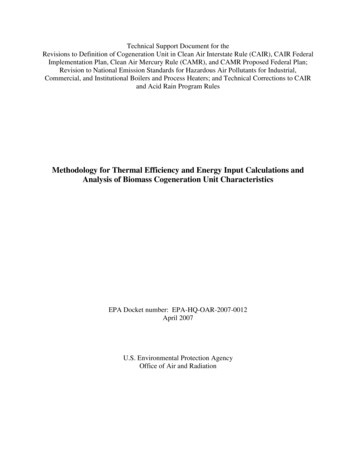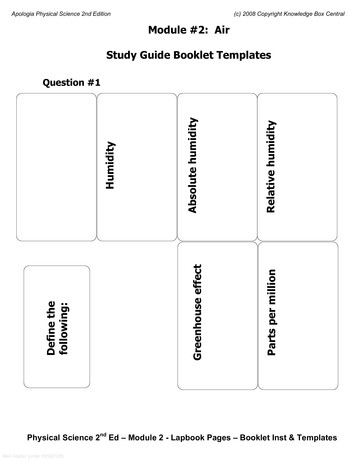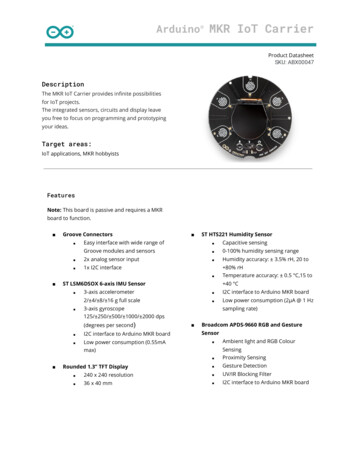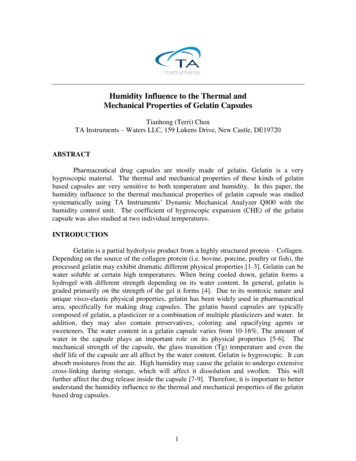
Transcription
Humidity Influence to the Thermal andMechanical Properties of Gelatin CapsulesTianhong (Terri) ChenTA Instruments – Waters LLC, 159 Lukens Drive, New Castle, DE19720ABSTRACTPharmaceutical drug capsules are mostly made of gelatin. Gelatin is a veryhygroscopic material. The thermal and mechanical properties of these kinds of gelatinbased capsules are very sensitive to both temperature and humidity. In this paper, thehumidity influence to the thermal mechanical properties of gelatin capsule was studiedsystematically using TA Instruments’ Dynamic Mechanical Analyzer Q800 with thehumidity control unit. The coefficient of hygroscopic expansion (CHE) of the gelatincapsule was also studied at two individual temperatures.INTRODUCTIONGelatin is a partial hydrolysis product from a highly structured protein – Collagen.Depending on the source of the collagen protein (i.e. bovine, porcine, poultry or fish), theprocessed gelatin may exhibit dramatic different physical properties [1-3]. Gelatin can bewater soluble at certain high temperatures. When being cooled down, gelatin forms ahydrogel with different strength depending on its water content. In general, gelatin isgraded primarily on the strength of the gel it forms [4]. Due to its nontoxic nature andunique visco-elastic physical properties, gelatin has been widely used in pharmaceuticalarea, specifically for making drug capsules. The gelatin based capsules are typicallycomposed of gelatin, a plasticizer or a combination of multiple plasticizers and water. Inaddition, they may also contain preservatives, coloring and opacifying agents orsweeteners. The water content in a gelatin capsule varies from 10-16%. The amount ofwater in the capsule plays an important role on its physical properties [5-6]. Themechanical strength of the capsule, the glass transition (Tg) temperature and even theshelf life of the capsule are all affect by the water content. Gelatin is hygroscopic. It canabsorb moistures from the air. High humidity may cause the gelatin to undergo extensivecross-linking during storage, which will affect it dissolution and swollen. This willfurther affect the drug release inside the capsule [7-9]. Therefore, it is important to betterunderstand the humidity influence to the thermal and mechanical properties of the gelatinbased drug capsules.1
The thermal properties of gelatin capsule have been studies using varieties ofdifferent techniques. DSC and modulus DSC have been used to determine performancerelated microstructural features such as the glass transition temperature (Tg), the meltingtemperature (Tm) and the melting enthalpy (Hm) [10-12]. Tg, Tm and Hm are importantparameters for monitoring process and storage induced structural changes and have beensuccessfully applied to the design and optimization of the gelatin capsule formulation.However, there are limited researches on studying the humidity influence to the thermaland mechanical properties of the capsules. TA Instruments DMA Q800 with thehumidity test chamber (shown in figure 1) is a powerful instrument which allow ofanalyzing the thermal and mechanical properties of gelatin capsule and other materialsunder both temperature and humidity control. It is equipped with varieties of clampfixtures, which allows samples to be measured with different dimensions. The humiditycontrol chamber is good for the temperature over the range of 5-120 C and the humidityover the range 5% to 95% RH. This is ideal for analyzing the property changes of gelatincapsule over its applications conditions. The objective of this study is to investigate thethermal and mechanical properties of gelatin capsule including glass transition (Tg),moduli (E’ and E”), and its coefficient of hygroscopic expansion (CHE).Figure 1: The TA Instruments Q800 Dynamic Mechanical Analyzer with the humiditycontrol accessory2
EXPERIMENTALThe gelatin capsule (size 000) is obtained from Torpac Inc. Based on themanufacturing report, this capsule is composed of gelatin (85% - 86%); de-ionized water(13% - 14%); methyl paraben ( 0.75%); propyl paraben (0.14%); and sodium laurylsulphate (0.14%). The capsule is cut into strips with a dimension of about 8-10mm longand 1-2 mm wide. The thickness of the capsule is reported to be 0.1mm.A TA instruments dynamic mechanical analyzer Q800 with the humidity controlchamber was used for all of the property tests. The sample specimen was loaded to theQ800 film tension clamp fixture (shown in figure 2). Based on the common applicationand storage conditions, the gelatin capsule samples were studied with the followingmethods.Figure 2 Sample Chamber of the DMA-RH Accessory1. Hold temperature constant, ramp the humidityThe gelatin specimen was loaded at ambient condition. Then it was equilibrated inthe chamber to the initial measurement temperature (i.e. 25 C; 37 C; 50 C respectively).After equilibration, held the temperature constant and ramped the relatively humidityfrom 0% to 90% at a rate of 2%/min. Held humidity at 90% for additional 15 minutes. Adynamic oscillatory test was conducted during the test at a frequency of 1 Hz and strainamplitude within the linear viscoelastic region of the material. The sample moduli (E’and E”) and tan delta parameters were recorded.2. Hold humidity constant, ramp temperatureThe gelatin specimen was loaded at ambient condition. Then it was equilibrated inthe chamber to the initial measurement temperature (20 C) and the initial relativehumidity (i.e. 5%; 50%; 60% and 80% respectively). After the equilibration, held the3
humidity constant and ramped the temperature from 20 C to 100 C at a rate of0.5 C/min. A dynamic oscillatory test was conducted at 1 Hz of frequency to monitorsample modulus change.3. Step the humidity to measure the Coefficient of Hygroscopic Expansion (CHE)The gelatin specimen was loaded at ambient condition. A static load of 0.01Nwas applied to the specimen. Then it was equilibrated in the chamber to the initialmeasurement temperature (i.e. 25 C; 37 C and 50 C respectively). The initial samplelength was recorded at the end of the equilibration. After the equilibration, the relativehumidity was increased with 10%RH per step from 10%RH up to 90% RH. The samplewas equilibrated at each humidity step for 2 hours until the sample displacement did notshow any further change. The sample displacement at each humidity step was recordedfor the calculation of sample CHE.RESULTS AND DISCUSSIONS1. Humidity influence to the glass transition of the gelatin capsuleGlass transition is associated with the polymer chain movements. It is animportant parameter for evaluating material’s storage and operation conditions. Belowthe glass transition, the material shows high stiffness and modulus. After the transition,the storage modulus drops about one to several decades and the material goes into arubbery state. In general, the glass transition of a material is very sensitive totemperature. If the material is hygroscopic, its glass transition will also be sensitive tothe relative humidity of the environment.Figure 3 shows the humidity ramp test results of gelatin capsule at 25 C; 37 Cand 50 C. The storage modulus of the sample was about the same at 4500MPa under lowhumidity below its glass transition. Based on the loss modulus curve, two transitionswere observed during the humidity ramp. The first transition showed at humidity of 51%- 55% was weak and broad. This transition was not very temperature sensitive. At 25 C,this transition peak showed at 51%RH. And at 50 C, it showed at 55%RH. The secondtransition showed at humidity from 78% up to 90%. This is the glass transition of thegelatin capsule. It is obvious from the test results that this transition is sensitive with themeasurement temperature. The higher the temperature, the transitions showed at lowerhumidity level. In addition, the storage modulus of the sample underwent significantdecrease during this transition. These results provide important information about theglass transitions of gelatin based capsule at storage temperatures.4
500010050 CLoss Modulus (MPa)Storage Modulus (MPa)4000300020001000030––––––– T25C-RAMP RH.001––––T37C-RAMP RH.001––––– ·T50C-RAMP RH.001405060Time (min)7040080300602004010020Relative Humidity (%)25 C09080Universal V4.7A TA InstrumentsFigure 3 The mechanical properties and glass transition of gelatin capsule measured at aconstant temperature with a 2%/min ramp in humidity2. Humidity influence to the mechanical strength of the gelatin capsuleAs reported by the manufacturer, the water content of the gelatin capsule is about13%. However, since gelatin is hygroscopic, it has the capability to absorb additionalwater from the environment. The additional amount of water can significantly lower theglass transition temperature and the modulus of the capsule. Figure 4 shows thetemperature ramp test results of gelatin capsule at different relative humidity. Whenbeing stored at relatively dried condition (e.g. RH 5%), gelatin capsule can remain stableover a broad temperature range. As the humidity of the environment increased up to50%, the storage modulus of the capsule starts to decrease at temperature higher than40 C. At 60% humidity, the storage modulus of the capsule at 20 C is only 50%compared with its dried condition. And it keeps dropping as temperature increases. Attemperature higher than 35-40 C, the modulus of the capsule has dropped more than onedecade and cannot be used as usual. These experimental results indicate that storagehumidity condition is important for the mechanical properties and shelf life of the gelatincapsules.5
10000plªlplpStorage Modulus (MPa)lplpllpl llpppªpª p p –––––––––––––––– ·––– – – 1020lpª 100lpª -50.003RH-60.001RH-80.002pp4060Temperature ( C)80100Universal V4.7A TA InstrumentsFigure 4 The storage modulus change as a function of temperature and humidity3. The CHE of the gelatin capsuleThe coefficient of thermal expansion (CTE) of a material is commonly measuredusing a TMA instrument. This CTE evaluates the dimension change of a material as afunction of temperature change. However, for a hygroscopic material, its dimension isalso sensitive to the environment humidity change. Therefore, understanding thecoefficient of hygroscopic expansion (CHE) is also important for evaluating the physicalproperties of a hygroscopic material.Figure 5 shows the dimension measurement results of gelatin capsule at 37 C anddifferent humidity level. Humidity equilibration is time consuming. The results fromfigure 5 show that for a gelatin capsule with thickness of 0.1mm, it takes at least 2 hoursfor the sample to reach equilibration at each humidity step. The sample length wasmeasured accurately at the end of each humidity step. The coefficient of hygroscopicexpansion (CHE) is obtained by taking the slop of sample displacement vs. relativehumidity. Figure 6 shows the CHE of gelatin capsule measured at 2 differenttemperatures.As can be seen from the humidity step test results in figure 5, at 37 C and 80%relative humidity, gelatin capsules undergo a significant shrinkage in dimensions. Thisindicates that at 37 C, the gelatin capsule is unstable being stored at humidity greaterthan 80%.6
Sample: 37C CHESize: 7.4366 x 1.9000 x 0.1000 mmMethod: Temperature RampDMAFile: W:\2011\Chen\DMA-RH\CHE\CHE-37C.001Operator: TCRun Date: 11-May-2011 10:42Instrument: DMA Q800 V20.24 Build 43400100806020040Relative Humidity (%)Displacement (µm)3001002000200400600Time (min)800012001000Universal V4.7A TA InstrumentsFigure 5 Dimension measurement of gelatin capsule at different humidity stepsCHE of Capsule at 37 C and 50 C350Displacement (mm)300250200150100500020406080RH (%)Figure 6 The coefficient of hygroscopic expansion (CHE) of gelatin capsule at differenttemperaturesCONCLUSIONSDue to its nontoxic nature, gelatin is commonly used in pharmaceutical industries.One major application is for the making of drug capsules. Over the years, many7
researches have been done to investigate the chemical and physical properties of thegelatin materials. However, since gelatin is hygroscopic, the water content in gelatin, themoisture level in the environment also plays an important role for the physical behaviorof the gelatin capsules. TA Instruments DMA Q800 with the humidity control chamberprovides a powerful technique for analyzing the thermal and mechanical properties ofgelatin capsules under both temperature and humidity control. The experimental resultsshow that the glass transition and the mechanical strength of gelatin capsule variessignificantly with the environment temperature and humidity. In addition, the Q800DMA can also measure the coefficient of hygroscopic expansion of gelatin capsule.These studies provide important information for the gelatin capsule manufacturing andstorage.REFERENCES[1] Ward, A.G.; Courts, A. “The Science and Technology of Gelatin”. New York: AcademicPress. ISBN 0127350500. (1977)[2] Herbert Gareis; Reinhard Schrieber . “Gelatine Handbook: Theory and Industrial Practice”.Weinheim: Wiley-VCH. ISBN 3-527-31548-9. (2007)[3] Mayo, K. H. Biopolymers (Peptide Sci) 1996, 40, 359–370.[4] British Standards Institution. “Methods for Sampling and Testing Gelatine”.St. London W1A 2BS. BS 757: (1975)2 Park[5] Kontny MJ; Mulski CA. “Gelatin Capsule Brittleness as a Function of RelativeHumidity at Room Temperature”. Int. J Pharm., 1989; 54, 79-85.[6] Marques MRC; Cole E; Kruep D et al. “Liquid-filled Gelatin Capsules”,Pharmacopeial Forum. 2009; Vol 35(4), 1029-1041[7] Murthy KS, Ender NA, Fawzi MB. “Dissolution Stability of Hard-shell Products.Part I. The Effect of Exaggerated Storage Conditions”. Pharm Technol. 1989; 13: 72-84[8] Murthy KS, Reisch RG, Fawzi MB. “Dissolution Stability of Hard-shell Products.Part II. The Effect of Dissolution Test Conditions on in Vitro Drug Release”. PharmTechnol. 1989; 13: 53-58[9] Ofner CM III, Zhang Y, Jobeck VC, bowman BJ. “Crosslinking Studies in GelatinCapsules Treated with Formaldehyde and in Capsules Exposed to Elevated temperatureand Humidity”. J Pharm Sci. 2001, 90 (1) 79-88.[10] Nazzal S, Wang Y. “Characterization of soft gelatin capsules by thermal analysis”.Int. J. Pharm. 2001, 230, 35-458
[11] Tseretely GI, Smirnova OI. “DSC Study of Melting and Glass Transition ingelatins”. J. of Thermal Analysis. 1992, Vol 38, 1189-1201[12] Dai CA, Chen YF, Liu MW. “Thermal Properties Measurements of DenaturedGelatin using Conventional and Temperature Modulated DSC”. J of Applied PolymerScience. 2006, 99, 1795-18019
temperature. If the material is hygroscopic, its glass transition will also be sensitive to the relative humidity of the environment. Figure 3 shows the humidity ramp test results of gelatin capsule at 25 C; 37 C and 50 C. The storage modulus of the sample was about the same at 4500MPa under low humidity below its glass transition.



